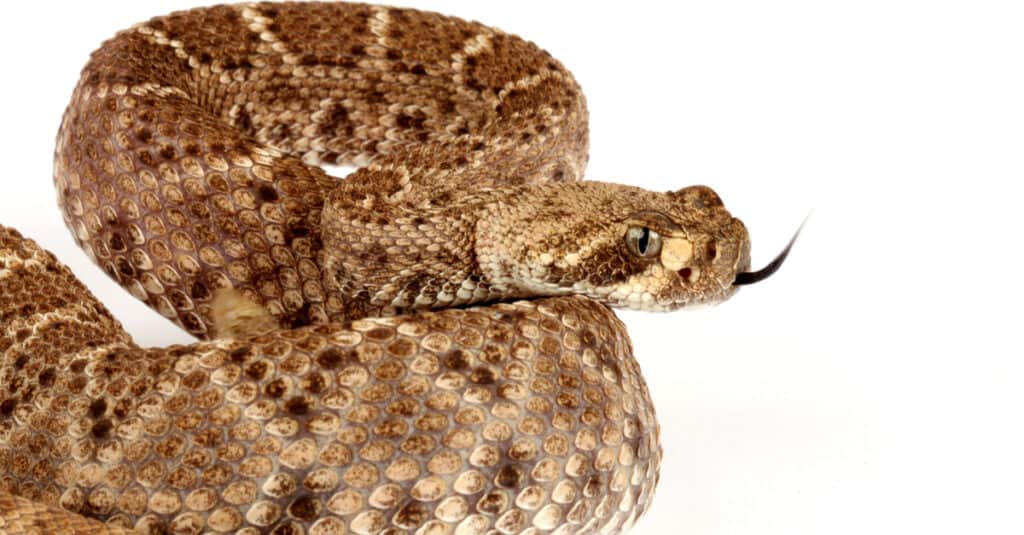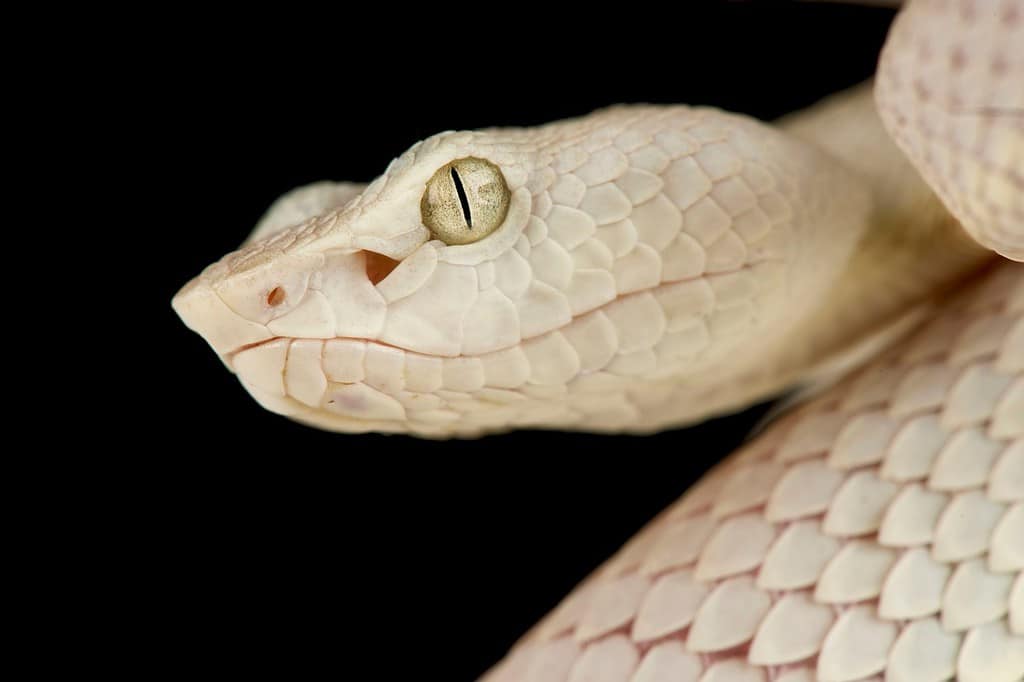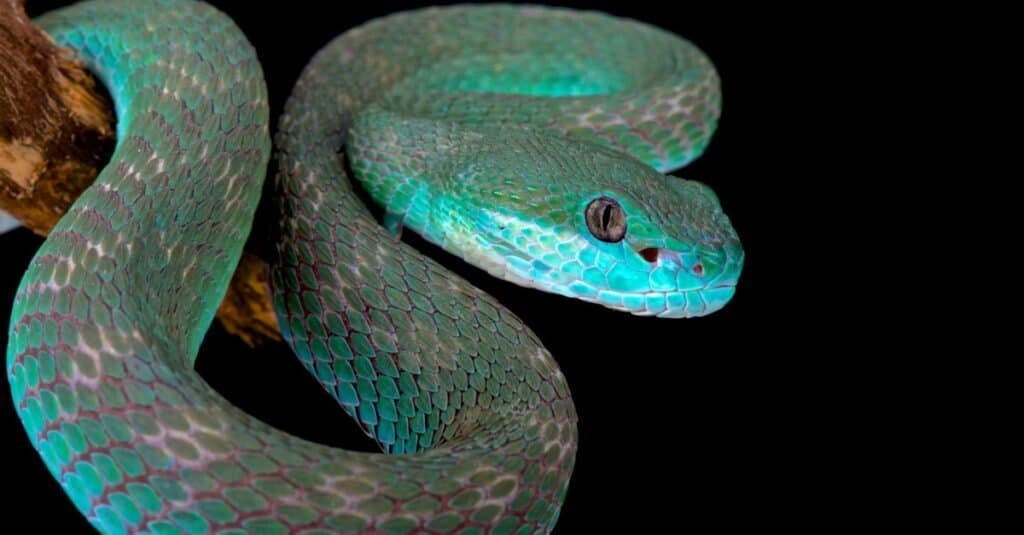No matter how you feel about snakes, there’s no denying that they are incredible for a variety of reasons. One of those reasons is that some species of snakes have the presence of a pit or hole on their face. But what exactly does this pit do, and how does it allow certain types of snakes to hunt in infrared in the dark?
In this article, we will cover everything having to do with heat-sensing pits, including what they allow pit vipers to do and why they matter. We will also discuss what types of snakes have heat-sensing pits and the types of prey that they hunt using this incredible sixth sense. Let’s get started and discuss heat-sensing pits now!

Loreal pits look like nostils on the faces of pit vipers, but they are far more than this.
©Audrey Snider-Bell/Shutterstock.com
What Are Loreal Pits?
Loreal pits look like noses on the faces of pit vipers, but they are far more than this. These holes allow snakes to see in infrared and hunt in the dark, as well as a variety of other things having to do with their senses.
In actuality, there is a sort of antenna hidden within the holes of a pit viper’s face. It hangs in this hollow chamber, sending signals to the snake’s brain when a warm body is detected nearby. By having this receptor in a hollow and ventilated location, snakes can easily detect changes in temperature, including the delicate temperatures of nearby prey.
But how exactly does this receptor detect heat signals? Let’s talk about this more in depth.
How Do Heat-Sensing Loreal Pits Work?

Some heat sensing pits are so advanced that they can sense heat signatures from meters away.
©reptiles4all/Shutterstock.com
One of the wildest things about viper pits is that they do not send or receive any signals from the eyes. This essentially confirms that snakes see in infrared and can detect prey in the dark without the use of their eyes at all!
Essentially, nearby animals heat up the viper pit’s sensor or perception and, once the pit notices a certain temperature has been reached, it sends signals to the snake’s brain. The signals illustrate the shape and size of the creature that is being picked up by the loreal pits, thus allowing snakes to see in infrared or through using heat signals.
Some are so advanced that they can sense heat signatures from meters away. Additionally, they can sense heat wavelengths in a temperature range of 10-30 micrometers. While this may not sound like much, this is exceedingly impressive and truly allows snakes to hunt in complete darkness!
Other Snakes that Have Heat-Sensing Pits

The blue White-lipped Island pitviper (Trimeresurus albolabris insularis) is endemic to Komodo island and surrounding islands.
©iStock.com/reptiles4all
Pit vipers aren’t the only snakes with heat-sensing pits. Most boas and pythons also have them, but they’re not called loreal pits — instead they’re called labial pits. Why the change? Location, location, location!! They’re named because of where they’re located on the snake’s face. In pit vipers, they’re located on the loreal scale which is between the nostril and eye. However, boas and pythons with pits have them located along their lips, either on or between the labial scales. Here are a a few more snakes with heat-sensing pits:
- Rattlesnakes
- Copperheads
- Cottonmouths
- Lanceheads
- Ball pythons
- Reticulated pythons
- Carpet pythons
- Anacondas
- Boa constrictors
This is only a small list of all of the snakes that have heat-sensing pits and are capable of seeing in infrared or heat sensing technology. It is impressive that so many snakes are able to hunt in this way, and truly shows their abilities to hunt in complete and utter darkness!
But how specifically do pits help snakes hunt, and how successful are snakes that hunt in this way? Let’s talk about this now.
Why Heat Sensing Pits Help Snakes Hunt

Boas use their pits to regularly hunt rodents that are active in the nighttime, giving these snakes an advantage over snakes without pits.
©Sanne Romijn Fotografie/Shutterstock.com
Having the ability to hunt in complete darkness is a benefit to a variety of snake species. Not only does it allow pit vipers to safely navigate the world in utter darkness, without threats from predators, but it also allows them to hunt prey that is in a vulnerable position.
Most birds enjoy diurnal existences, which means that they are asleep in the nighttime. This allows snakes to easily hunt and consume them, even if that notion is a bit sad. However, most snakes enjoy rodents, and a variety of rodents are also nocturnal. This means that pit vipers use their pits to regularly hunt rodents that are active in the nighttime, giving these snakes an advantage over snakes without viper pits.
The advanced technology involved in this adaptation allows pit vipers to sense temperature changes in a variety of different environments. Not only can they sense heat signatures from prey, but studies suggest that vipers utilize these pits to find cooler areas that they can rest in as well.
Given that pit vipers can sense temperature differences of as little as 10 degrees using these pits, it can be assumed that they utilize this ability to protect themselves as well. Having the ability to tell whether or not there is prey nearby in as little as a single second can make all the difference for wild snakes!
What Other Animals Can See in Infrared?

The advanced technology involved in this adaptation allows anacondas to sense temperature changes in a variety of different environments.
©Mark_Kostich/Shutterstock.com
Snakes are unique in that they are one of only a few animals that can truly see in infrared. Most other animals that utilize infrared to survive are cold blooded, which makes sense considering their need to seek out heat.
Other creatures capable of seeing in infrared include:
- Mosquitoes
- Select beetle species
- Some fish species, such as salmon
- Some other insect species, such as bed bugs
- Many bat species, such as vampire bats
- Some frog species, such as bullfrogs
Additionally, some mammals are able to sense heat. However, usually this is using their sense of smell rather than a separate infrared ability. Some of these creatures include wolves and foxes, which makes sense when you consider their ability to hunt and take down warm-blooded prey.
Very few other animals have the same unique abilities as snakes do. This makes their infrared viper pits a fascinating thing to study! There’s no denying how impressive it is to see a snake hunt in complete accuracy and total darkness.
The photo featured at the top of this post is © Scott Delony/Shutterstock.com
Discover the "Monster" Snake 5X Bigger than an Anaconda
Every day A-Z Animals sends out some of the most incredible facts in the world from our free newsletter. Want to discover the 10 most beautiful snakes in the world, a "snake island" where you're never more than 3 feet from danger, or a "monster" snake 5X larger than an anaconda? Then sign up right now and you'll start receiving our daily newsletter absolutely free.
Thank you for reading! Have some feedback for us? Contact the AZ Animals editorial team.






